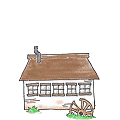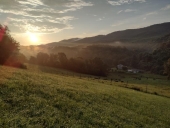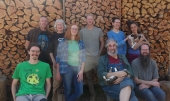








Jay Hart wrote:Hi my name is Jay Hart. I'm 21 years old and live on as island just off the coast of Charleston SC. I've been interested in permaculture for a while-- just found the stuff on the internet and started buying books and trying stuff out around the property, even went wwoofing for a bit . Anyways, I've been reading all the stuff on the forums here about WOTFATI and ATI so I went and read an article by John Hait (http://www.norishouse.com/PAHS/UmbrellaHouse.html) and in it he mentions that a second generation umbrella house was constructed in Missoula Montana by a guy named Tom Beaudette. I havent got my hands on his book yet, so maybe there is more on it in there but I know a lot of you guys, most notably Mr. Wheaton himself live up that ways and i was just wondering if anyone had been out to see it and if so if they had any pictures or videos that they could direct me too. It looks pretty amazing in the picture he had in the article but I couldn't find much else outside of what is mentioned in the article and I am VERY interested to see what it looks like and how it works if at all possible.
Thanks a lot for reading. Peace be with you.
 The only PAHS house I have seen that seems to have worked well and is still lived in by the original builder, was above ground and simply built of cinder block. It had minimal indoor plants (read less moisture/mold problems) and very good ventilation. The owner also consults, but gives enough info for you not to need his services. see here (and note: lots of people don't like his attitude towards other building methods) Also, Walter's house At Sugar Mountain is even simpler, but works well. In fact he uses high mass temperature control techniques for keeping his butcher shop chilled as well. Cob buildings have done very well too. The underground homes that the wofati is based on have done well, but really, in my opinion, they are above ground bermed homes. Much attention is given to drainage. (am I seeing a pattern here?)
The only PAHS house I have seen that seems to have worked well and is still lived in by the original builder, was above ground and simply built of cinder block. It had minimal indoor plants (read less moisture/mold problems) and very good ventilation. The owner also consults, but gives enough info for you not to need his services. see here (and note: lots of people don't like his attitude towards other building methods) Also, Walter's house At Sugar Mountain is even simpler, but works well. In fact he uses high mass temperature control techniques for keeping his butcher shop chilled as well. Cob buildings have done very well too. The underground homes that the wofati is based on have done well, but really, in my opinion, they are above ground bermed homes. Much attention is given to drainage. (am I seeing a pattern here?)
 I would like to get comments about some of the first wofati before I try it. My sense is that they will work well though.
I would like to get comments about some of the first wofati before I try it. My sense is that they will work well though.



My tree nursery: https://mountaintimefarm.com/




Abe Coley wrote:I live in Missoula and I know where that house is. The owners are very, very old. I asked the guy if me and Paul could come look at it, and that we'd trade him pie and farm fresh eggs for a tour, but he said his wife doesn't want strangers coming in the house. Apparently they've got a lot of requests over the years.






|
There's just something sexy about this tiny ad
montana community seeking 20 people who are gardeners or want to be gardeners
https://permies.com/t/359868/montana-community-seeking-people-gardeners
|





